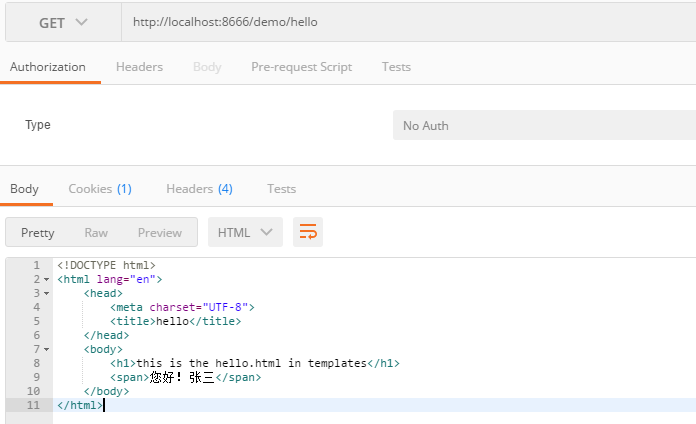参考文章:https://blog.csdn.net/qq_34410726/article/details/98214992
一、maven分布式工程的基本架构
demo #父工程模块,主要用来定义整个分布式工程的依赖版本
---- common #公共模块,主要用来定义一些公共的组件,比如实体类等
---- function-one #功能模块1,引入common模块
---- function-two #功能模块2,引入common模块
---- pom.xml
二、maven父工程demo的搭建
1.打开IDEA,File->New->New Project,然后选择Empty Project,如下:
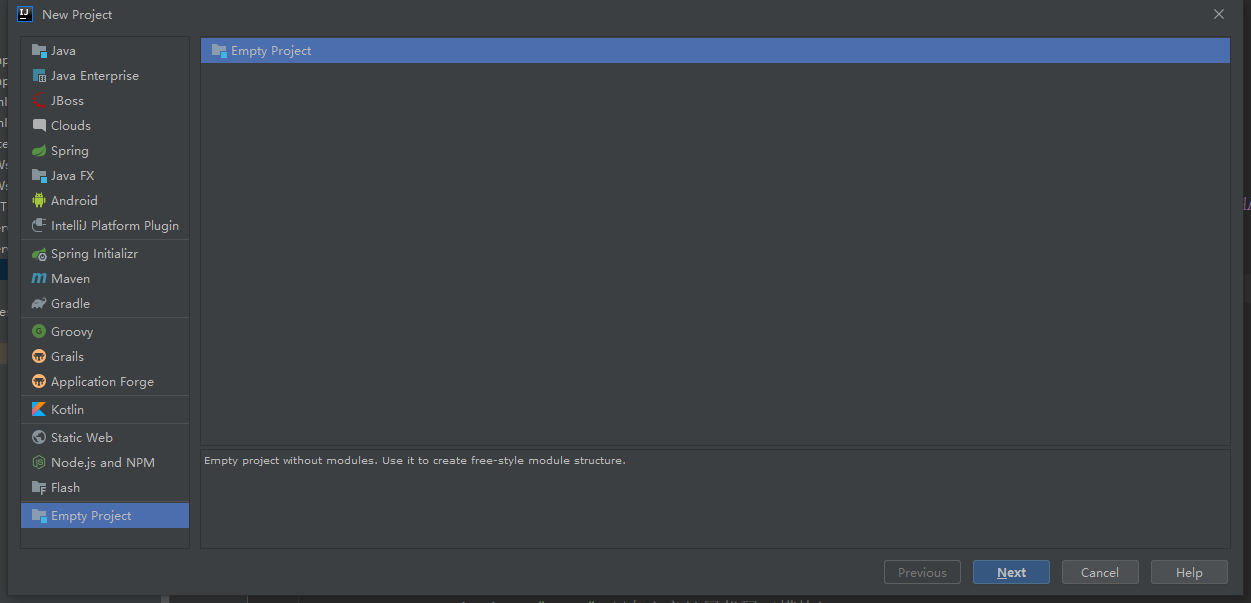

接下来会弹出窗口让我们新建modules,点击+号,新建一个父工程,也就是一个父module。然后我们选择maven工程,选择jd 版本
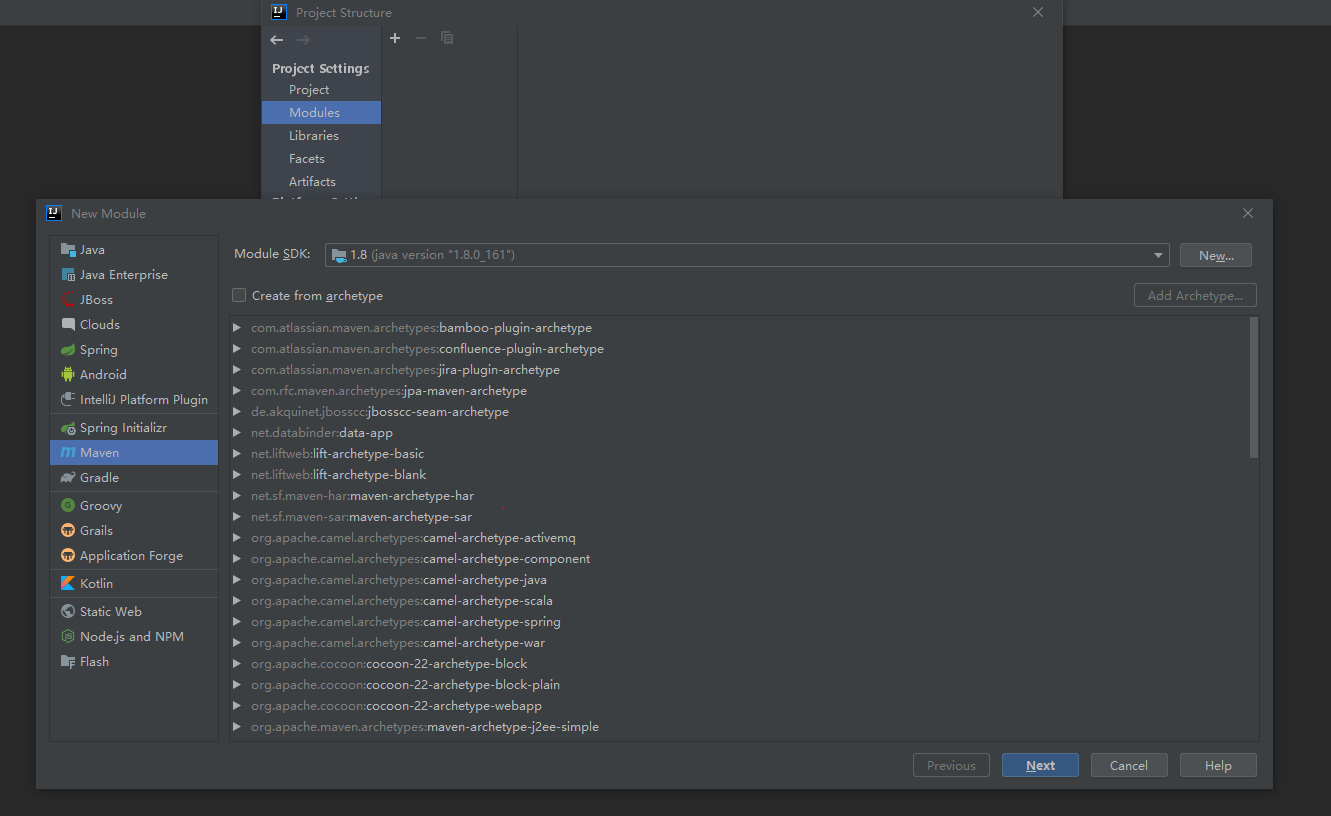

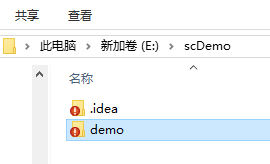
2.pom.xml
创建好之后,该父工程demo是个空的maven工程,只有src目录和pom.xml文件,删除src目录,修改pom.xml
<?xml version="1.0" encoding="UTF-8"?> <project xmlns="http://maven.apache.org/POM/4.0.0" xmlns:xsi="http://www.w3.org/2001/XMLSchema-instance" xsi:schemaLocation="http://maven.apache.org/POM/4.0.0 http://maven.apache.org/xsd/maven-4.0.0.xsd"> <modelVersion>4.0.0</modelVersion> <groupId>com.sc</groupId> <artifactId>demo</artifactId> <version>1.0-SNAPSHOT</version> <packaging>pom</packaging> <name>demo</name> <description>This is parent project</description> <!-- 子模块清单(创建新子模块后,会自动填入)--> <modules> <module>common</module> <module>function-one</module> <module>function-two</module> </modules> <!-- 本项目的父模块使用spring-boot框架 --> <parent> <groupId>org.springframework.boot</groupId> <artifactId>spring-boot-starter-parent</artifactId> <version>2.0.2.RELEASE</version> </parent> <!-- 项目自定义属性 --> <properties> <project.build.sourceEncoding>UTF-8</project.build.sourceEncoding> <project.reporting.outputEncoding>UTF-8</project.reporting.outputEncoding> <java.version>1.8</java.version> <!-- 依赖的版本号:在定义版本时,要注意的是不同的依赖版本之间会有影响,有些最新的版本不支持其他依赖的低版本一起使用--> <mysql.driver.version>5.1.29</mysql.driver.version> <org.mybatis.spring.boot.version>1.3.1</org.mybatis.spring.boot.version> <alibaba.druid.version>1.1.9</alibaba.druid.version> <spring.cloud.version>Edgware.SR1</spring.cloud.version> </properties> <!-- 项目依赖项 --> <dependencyManagement> <!-- dependencyManagement只是声明依赖,并不实现引入 --> <dependencies> <!-- Spring Cloud --> <dependency> <groupId>org.springframework.cloud</groupId> <artifactId>spring-cloud-dependencies</artifactId> <version>${spring.cloud.version}</version> <type>pom</type> <scope>import</scope> </dependency> </dependencies> </dependencyManagement> <dependencies> <!-- Spring Boot --> <dependency> <groupId>org.springframework.boot</groupId> <artifactId>spring-boot-starter</artifactId> <version>2.0.2.RELEASE</version> </dependency> <dependency> <groupId>org.springframework.boot</groupId> <artifactId>spring-boot-starter-web</artifactId> <version>2.0.2.RELEASE</version> </dependency> <dependency> <groupId>org.springframework.boot</groupId> <artifactId>spring-boot-starter-test</artifactId> <scope>test</scope> </dependency> <!-- 添加junit4依赖 单元测试--> <dependency> <groupId>junit</groupId> <artifactId>junit</artifactId> <version>4.12</version> <scope>test</scope> </dependency> <!-- 切面 --> <dependency> <groupId>org.aspectj</groupId> <artifactId>aspectjweaver</artifactId> <version>1.8.8</version> </dependency> <!-- 简化Entity代码(实体类添加@Data,编译时为所有字段添加@ToString/@EqualsAndHashCode/@Getter/为非final字段添加@Setter) --> <dependency> <groupId>org.projectlombok</groupId> <artifactId>lombok</artifactId> <version>1.16.20</version> </dependency> <!-- 添加mybatis依赖--> <dependency> <groupId>org.mybatis.spring.boot</groupId> <artifactId>mybatis-spring-boot-starter</artifactId> <version>${org.mybatis.spring.boot.version}</version> </dependency> <!-- 添加mysql驱动依赖 --> <dependency> <groupId>mysql</groupId> <artifactId>mysql-connector-java</artifactId> <scope>runtime</scope> <version>${mysql.driver.version}</version> </dependency> <!-- 添加数据库连接池依赖 --> <dependency> <groupId>com.alibaba</groupId> <artifactId>druid</artifactId> <version>${alibaba.druid.version}</version> </dependency> </dependencies> <!-- <scope>主要管理依赖的部署 * compile,缺省值,适用于所有阶段,会随着项目一起发布。 * provided,类似compile,期望JDK、容器或使用者会提供这个依赖。如servlet.jar。 * runtime,只在运行时使用,如JDBC驱动,适用运行和测试阶段。 * test,只在测试时使用,用于编译和运行测试代码。不会随项目发布。 * system,类似provided,需要显式提供包含依赖的jar,Maven不会在Repository中查找它。 --> <build> <plugins> <!--打包跳过测试--> <plugin> <groupId>org.apache.maven.plugins</groupId> <artifactId>maven-surefire-plugin</artifactId> <configuration> <skip>true</skip> </configuration> </plugin> </plugins> </build> </project>
三、maven子工程common模块的搭建
1.创建
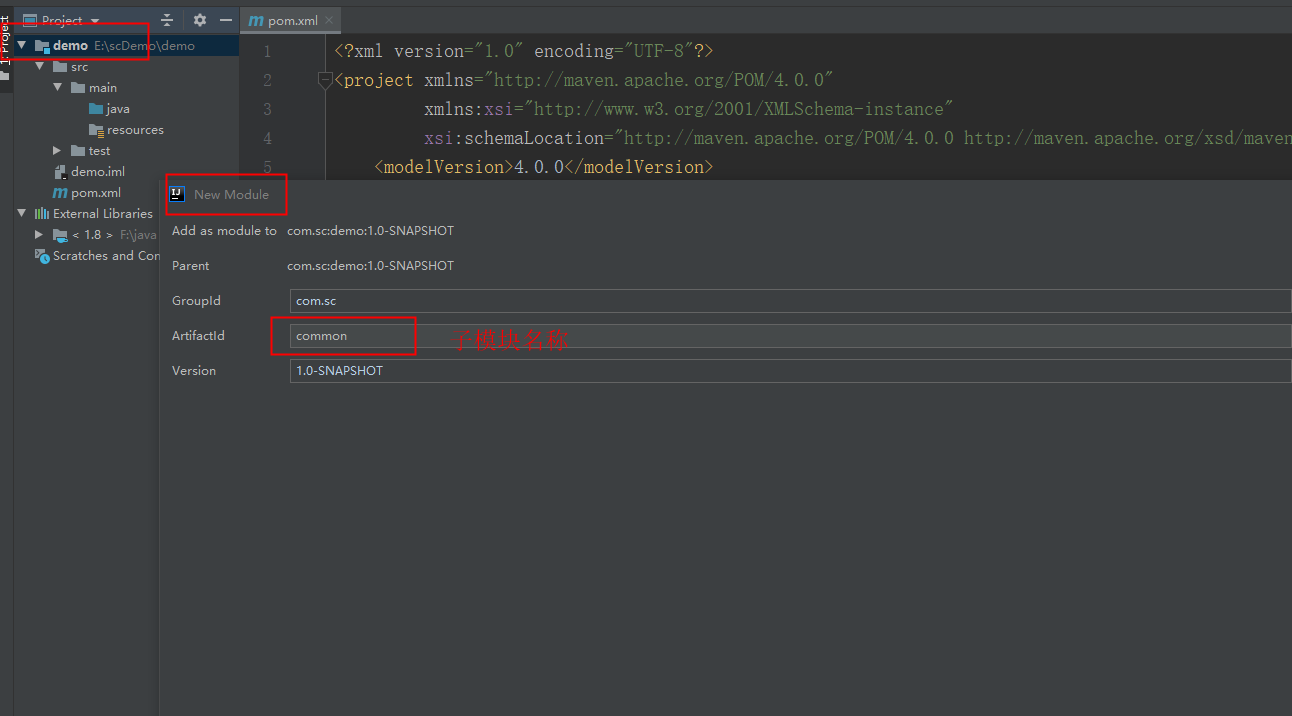
2.创建之后,只有src空目录和pom.xml,我们可以把图中这些文件放在common公共模块中

3.pom.xml
<?xml version="1.0" encoding="UTF-8"?> <project xmlns="http://maven.apache.org/POM/4.0.0" xmlns:xsi="http://www.w3.org/2001/XMLSchema-instance" xsi:schemaLocation="http://maven.apache.org/POM/4.0.0 http://maven.apache.org/xsd/maven-4.0.0.xsd"> <parent> <groupId>com.sc</groupId> <artifactId>demo</artifactId> <version>1.0-SNAPSHOT</version> </parent> <modelVersion>4.0.0</modelVersion> <artifactId>common</artifactId> <version>1.0-SNAPSHOT</version> <packaging>jar</packaging> <properties> <!-- 依赖的版本号 --> <joda.time.version>2.9.9</joda.time.version> <commons.lang.version>2.6</commons.lang.version> <commons.io.version>2.5</commons.io.version> <fastjson.version>1.2.29.sec06</fastjson.version> <pinyin4j.version>2.5.1</pinyin4j.version> <commons.codec.version>1.9</commons.codec.version> </properties> <dependencies> <!-- 在Java中处理日期和时间是很常见的需求,基础的工具类就是我们熟悉的Date和Calendar,然而这些工具类的api使用并不是很方便和强大,于是就诞生了Joda-Time这个专门处理日期时间的库。--> <dependency> <groupId>joda-time</groupId> <artifactId>joda-time</artifactId> <version>${joda.time.version}</version> </dependency> <dependency> <groupId>commons-lang</groupId> <artifactId>commons-lang</artifactId> <version>${commons.lang.version}</version> </dependency> <dependency> <groupId>commons-io</groupId> <artifactId>commons-io</artifactId> <version>${commons.io.version}</version> </dependency> <!-- fastJson用于对JSON格式的数据进行解析和打包 --> <dependency> <groupId>com.alibaba</groupId> <artifactId>fastjson</artifactId> <version>${fastjson.version}</version> </dependency> <!-- 用于转换拼音,调用PinyinHelper类的静态工具方法 --> <dependency> <groupId>com.belerweb</groupId> <artifactId>pinyin4j</artifactId> <version>${pinyin4j.version}</version> </dependency> <!-- redis --> <dependency> <groupId>org.springframework.boot</groupId> <artifactId>spring-boot-starter-data-redis</artifactId> </dependency> <!-- 用于摘要运算、编码解码 --> <dependency> <groupId>commons-codec</groupId> <artifactId>commons-codec</artifactId> <version>${commons.codec.version}</version> </dependency> <!-- JPA的宗旨是为POJO提供持久化标准规范,比如@Table注解 --> <dependency> <groupId>javax.persistence</groupId> <artifactId>persistence-api</artifactId> <version>1.0</version> </dependency> <!-- thymeleaf:前后端数据交互模板引擎 --> <dependency> <groupId>org.springframework.boot</groupId> <artifactId>spring-boot-starter-thymeleaf</artifactId> </dependency> </dependencies> </project>
4.安装lombok插件,创建一个实体类UserEntity.java
lombok插件:简化Entity实体类,@Data,可以免写set/get方法

UserEntity.java
package entity.one; import lombok.Data; import javax.persistence.Column; import javax.persistence.Table; @Data @Table(name = "user") public class UserEntity { @Column(name = "id") private Integer id; @Column(name = "name") private String name; @Column(name = "age") private Integer age; }
5.新建Mapper层类
UserMapper.java
package mapper.one; import entity.one.UserEntity; import org.apache.ibatis.annotations.Param; import org.apache.ibatis.annotations.Select; import org.springframework.stereotype.Component; import java.util.List; @Component public interface UserMapper{ @Select("SELECT * FROM user") List<UserEntity> getList(); UserEntity getById(@Param("id") Integer id); }
UserMapper.xml
<?xml version="1.0" encoding="UTF-8"?> <!DOCTYPE mapper PUBLIC "-//mybatis.org//DTD Mapper 3.0//EN" "http://mybatis.org/dtd/mybatis-3-mapper.dtd"> <mapper namespace="mapper.one.UserMapper"> <resultMap id="BaseResultMap" type="entity.one.UserEntity"> <id column="id" jdbcType="INTEGER" property="id" /> <result column="name" jdbcType="VARCHAR" property="name" /> <result column="age" jdbcType="INTEGER" property="age" /> </resultMap> <select id="getById" resultType="entity.one.UserEntity"> SELECT * FROM user WHERE id = #{id} </select> </mapper>
四、maven子工程function-one模块的搭建
1.创建之后,添加一些目录,function-two类似

2.pom.xml,function-two也引入common包
<?xml version="1.0" encoding="UTF-8"?> <project xmlns="http://maven.apache.org/POM/4.0.0" xmlns:xsi="http://www.w3.org/2001/XMLSchema-instance" xsi:schemaLocation="http://maven.apache.org/POM/4.0.0 http://maven.apache.org/xsd/maven-4.0.0.xsd"> <parent> <groupId>com.sc</groupId> <artifactId>demo</artifactId> <version>1.0-SNAPSHOT</version> </parent> <modelVersion>4.0.0</modelVersion> <artifactId>function-one</artifactId> <packaging>jar</packaging> <dependencies> <!-- 引入自己定义的common通用包 --> <dependency> <groupId>com.sc</groupId> <artifactId>common</artifactId> <version>1.0-SNAPSHOT</version> </dependency> </dependencies> </project>
3.application.yml
server:
port: 8666
servlet:
context-path: /demo
spring:
datasource:
url: jdbc:mysql://127.0.0.1:3306/demo_one?useSSL=false&useUnicode=true&characterEncoding=utf-8
username: root
password: 123456
driver-class-name: com.mysql.jdbc.Driver
type: com.alibaba.druid.pool.DruidDataSource
#thymeleaf
thymeleaf:
prefix: classpath:/templates/
suffix: .html
cache: false
servlet:
content-type: text/html
enabled: true
encoding: UTF-8
mode: HTML5
mybatis:
mapper-locations: classpath:mapper/*.xml #配置映射文件
type-aliases-package: entity #配置实体类
function-two,端口号8888,连接的数据库demo_two
4.OneApplication.java
package com.demo; import com.ctrip.framework.apollo.spring.annotation.EnableApolloConfig; import org.mybatis.spring.annotation.MapperScan; import org.springframework.boot.SpringApplication; import org.springframework.boot.autoconfigure.SpringBootApplication; @SpringBootApplication @MapperScan({"mapper"}) //项目启动时会扫描mapper接口,否则会报错找不到mapper文件
public class OneApplication {
public static void main(String[] args) { SpringApplication.run(OneApplication.class, args); } }
五、测试
一、直接后台测试
common模块的UserEntity.java、UserMapper.java、UserMapper.xml
function-one模块:
1.UserController.java
import org.springframework.web.bind.annotation.PathVariable; import org.springframework.web.bind.annotation.RequestMapping; import org.springframework.web.bind.annotation.RestController; import com.demo.service.UserService; import java.util.List; @RestController @RequestMapping("/user") public class UserController { @Autowired private UserService userService; @GetMapping("/getList") public List<UserEntity> getList(){ return userService.getList(); } @GetMapping("/getById/{id}") public UserEntity getById(@PathVariable("id") Integer id){ return userService.getById(id); } }
2.UserService.java
package com.demo.service; import entity.one.UserEntity; import java.util.List; public interface UserService{ List<UserEntity> getList(); UserEntity getById(Integer id); }
3.UserServiceImpl.java
package com.demo.service.impl; import entity.one.UserEntity; import mapper.one.UserMapper; import org.springframework.beans.factory.annotation.Autowired; import org.springframework.stereotype.Service; import com.demo.service.UserService; import java.util.List; @Service public class UserServiceImpl implements UserService { @Autowired private UserMapper userMapper; @Override public List<UserEntity> getList() { return userMapper.getList(); } @Override public UserEntity getById(Integer id) { return userMapper.getById(id); } }
4.测试
http://localhost:8666/demo/user/getList
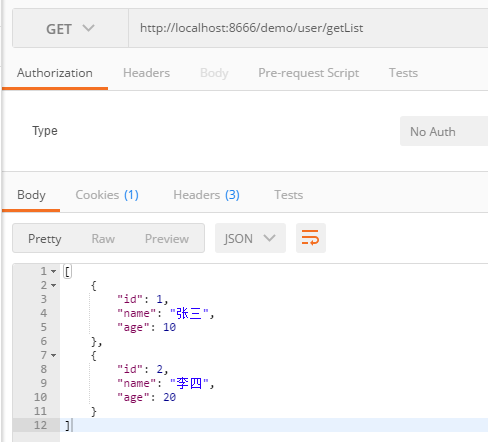
二、前后端交互数据测试
1.利用前后端数据交互模板引擎:thymeleaf
引入包,然后在.yml中添加配置
resources/templates目录下hello.html
<!DOCTYPE html> <html lang="en" xmlns:th="http://www.w3.org/1999/xhtml"> <head> <meta charset="UTF-8"> <title>hello</title> </head> <body> <h1>this is the hello.html in templates</h1> <span th:text="${key}"></span> </body> </html>
2.HelloController.java
package com.demo.controller; import com.demo.service.UserService; import org.springframework.beans.factory.annotation.Autowired; import org.springframework.stereotype.Controller; import org.springframework.web.bind.annotation.RequestMapping; import org.springframework.web.servlet.ModelAndView; @Controller //需跳转到页面,不能用@RestController public class HelloController { @Autowired private UserService userService; @RequestMapping("/hello") public ModelAndView sayHello(){ ModelAndView modelAndView = new ModelAndView(); modelAndView.setViewName("hello"); String name = userService.getById(1).getName(); modelAndView.addObject("key", "您好!"+ name); return modelAndView; } }
3.测试
http://localhost:8666/demo/hello
